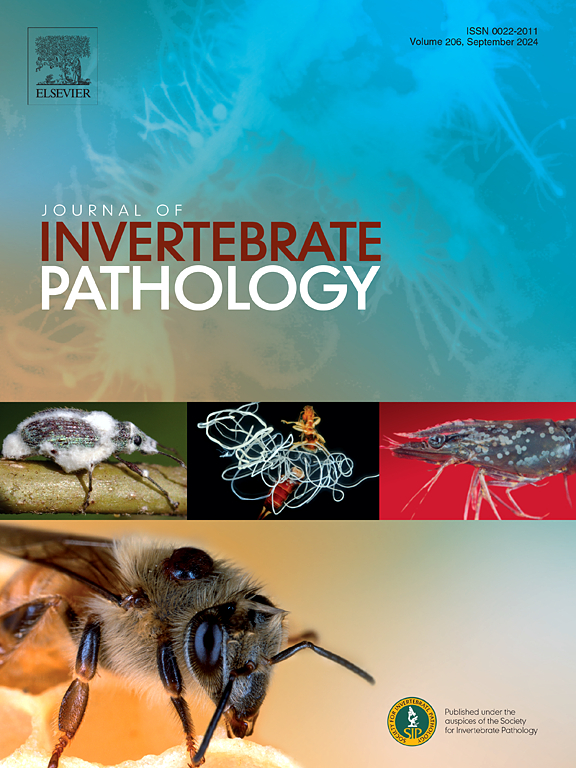Identification of function modules in the co-expression protein–protein interaction network of Bombyx mori in response to Beauveria bassiana infection
IF 2.4
3区 生物学
Q1 ZOOLOGY
引用次数: 0
Abstract
Beauveria bassiana (B. bassiana) is a common fungal disease in sericulture. Previous research has primarily focused on investigating genes involved in innate immunity. However, the response of Bombyx mori (B. mori) to B. bassiana requires the coordination of other biological processes in addition to the immune system. We measured protein expression profile of B. mori after inoculating B. bassiana using iTRAQ technology in previous. Here we constructed a co-expression protein–protein interaction network of B. mori in response to B. bassiana infection. Subnetworks and modules were analyzed, and the functions of these modules were annotated. The results revealed the identification of numerous proteins associated with cellular immunity, including those involved in phagosomes, lysosomes, mTOR signaling, sugar metabolism, and the ubiquitin–proteasome pathway. Meanwhile, we observed that the pathways involved in protein synthesis were activated, including pyruvate and purine metabolism, RNA transport, ribosome, protein processing in endoplasmic reticulum, and protein export pathways, during B. bassiana infection. Based on this analysis, we selected six candidate genes (shock protein, ribosome, translocon, actin muscle-type A2, peptidoglycan recognition protein, and collagenase) that were found to be related to the response to B. bassiana. Further verification experiments demonstrated significant changes in their expression levels after inoculation with B. bassiana. These research findings provide new insights into the molecular mechanism of insect immune response to fungal infection.

确定桑蚕对巴氏杆菌感染的共表达蛋白-蛋白相互作用网络中的功能模块。
Beauveria bassiana(B. bassiana)是一种常见的养蚕真菌疾病。以往的研究主要集中于研究先天免疫相关基因。然而,桑蚕(Bombyx mori)对 B. bassiana 的反应除了需要免疫系统外,还需要其他生物过程的协调。以前我们曾利用 iTRAQ 技术测量了 B. mori 接种 B. bassiana 后的蛋白质表达谱。在此,我们构建了森蝽在应对 B. bassiana 感染时的共表达蛋白-蛋白相互作用网络。我们分析了子网络和模块,并对这些模块的功能进行了注释。结果发现了许多与细胞免疫相关的蛋白质,包括参与吞噬体、溶酶体、mTOR 信号转导、糖代谢和泛素-蛋白酶体通路的蛋白质。同时,我们观察到,在 B. bassiana 感染期间,参与蛋白质合成的途径被激活,包括丙酮酸和嘌呤代谢、RNA 转运、核糖体、内质网蛋白质加工和蛋白质输出途径。根据这一分析,我们选出了六个候选基因(休克蛋白、核糖体、转座子、肌动蛋白 A2 型、肽聚糖识别蛋白和胶原酶),发现它们与 B. bassiana 的反应有关。进一步的验证实验表明,接种 B. bassiana 后,它们的表达水平发生了显著变化。这些研究成果为昆虫对真菌感染的免疫反应分子机制提供了新的见解。
本文章由计算机程序翻译,如有差异,请以英文原文为准。
求助全文
约1分钟内获得全文
求助全文
来源期刊
CiteScore
6.10
自引率
5.90%
发文量
94
审稿时长
1 months
期刊介绍:
The Journal of Invertebrate Pathology presents original research articles and notes on the induction and pathogenesis of diseases of invertebrates, including the suppression of diseases in beneficial species, and the use of diseases in controlling undesirable species. In addition, the journal publishes the results of physiological, morphological, genetic, immunological and ecological studies as related to the etiologic agents of diseases of invertebrates.
The Journal of Invertebrate Pathology is the adopted journal of the Society for Invertebrate Pathology, and is available to SIP members at a special reduced price.

 求助内容:
求助内容: 应助结果提醒方式:
应助结果提醒方式:


